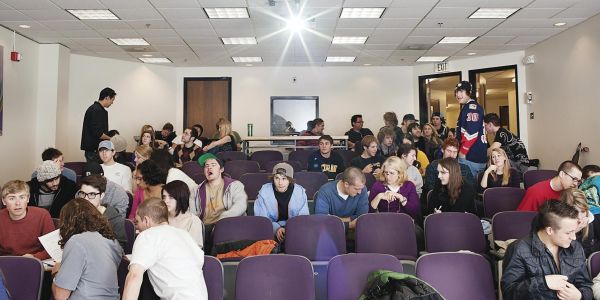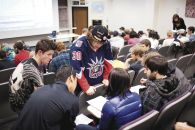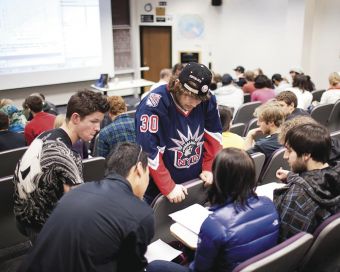Andrew P. Martin loves it when his lectures break out in chaos.
It happens frequently, when he asks the 80 students in his evolutionary-biology class at the University of Colorado at Boulder to work in small groups to solve a problem, or when he asks them to persuade one another that the answer they arrived at before class is correct.
When they start working together, his students rarely stay in their seats, which are bolted to the floor. Instead they gather in the hallway or in the aisles, or spill toward the front of the room, where the professor typically stands.
Mr. Martin, a professor of ecology and evolutionary biology, drops in on the discussions, asking and answering questions, and hearing where students are stumped. "Students are effectively educating each other," he says of the din that overtakes his room. "It means they're in control, and not me."
Such moments of chaos are embraced by advocates of a teaching technique called "flipping." As its name suggests, flipping describes the inversion of expectations in the traditional college lecture. It takes many forms, including interactive engagement, just-in-time teaching (in which students respond to Web-based questions before class, and the professor uses this feedback to inform his or her teaching), and peer instruction.
But the techniques all share the same underlying imperative: Students cannot passively receive material in class, which is one reason some students dislike flipping. Instead they gather the information largely outside of class, by reading, watching recorded lectures, or listening to podcasts.
And when they are in class, students do what is typically thought to be homework, solving problems with their professors or peers, and applying what they learn to new contexts. They continue this process on their own outside class.
The immediacy of teaching in this way enables students' misconceptions to be corrected well before they emerge on a midterm or final exam. The result, according to a growing body of research, is more learning.
While the idea is not new, the topic of flipping has consistently cropped up during discussions at recent conferences about teaching and learning—and often when the subject turns to science, technology, engineering, and mathematics, or the STEM disciplines.
The recent interest is driven by the convergence of several trends.
The first is technological innovation, which has made it easier to distribute lectures by the world's leading instructors. Some faculty members wonder whether it still makes sense to deliver a lecture when students can see the same material covered more authoritatively and engagingly—and at their own pace and on their own schedule. The supply of such offerings, at low or no cost, is increasing, as demonstrated by recent news of the Massachusetts Institute of Technology's founding of MITx and a Stanford University professor's start-up of Udacity.
At the same time, policy makers, scholars, advocacy groups, and others who seek to improve higher education want to see more evidence that students are truly learning in college. As pressure mounts to graduate more students, and as cognitive psychology produces new insights into how students learn, these observers say professors can no longer simply pump out information and take it on faith that students understand it.
Adding to these forces is economic reality. Strained budgets make it difficult for colleges to decrease class sizes and create more seminars in which low student-to-professor ratios allow a high degree of personal attention. Even advocates for new approaches to teaching concede that the lecture is not going away. The lecture model—putting dozens, hundreds, or even thousands of students in a room with a professor—endures because it makes economic sense.
Flipping allows colleges, particularly large research institutions with big classes, to make the traditional lecture model more productive, says Harrison Keller, vice provost for higher-education policy at the University of Texas at Austin, which held a recent seminar on course flipping for its faculty. "If you do this well, you can use faculty members' time and expertise more appropriately, and you can also use your facilities more efficiently," he says. More important, "you can get better student-learning outcomes."
Those forces are coming together to prompt a rethinking of the faculty member's role in the classroom. "I see a paradigm shift, and it's coming soon," says Michael S. Palmer, an associate professor of chemistry and assistant director of the Teaching Resource Center at the University of Virginia. "Content is not going to be the thing we do. We're going to help unpack that content."
Identifying Key Concepts
Professors have flipped courses for decades. Humanities professors expect their students to read a novel on their own and do not dedicate class time to going over the plot. Class time is devoted to exploring symbolism or drawing out themes. And law professors have long used the Socratic method in large lectures, which compels students to study the material before class or risk buckling under a barrage of their professor's questions.
The way STEM disciplines are traditionally taught makes them particularly ripe for change, Mr. Palmer says, because of their "long tradition of very didactic teaching, which involved disseminating content." By contrast, he says, the humanities and social sciences have been about exploring ideas.
Still, flipping has been adopted in isolated precincts of STEM disciplines, particularly physics. Some of the most notable examples illustrate the different forms the technique can take.
At the University of Michigan at Ann Arbor, for example, the math department has flipped its teaching of calculus since the mid-1990s, says Karen Rhea, a lecturer and director of the introductory mathematics program.
Michigan offers up to 60 small sections of introductory calculus, with a maximum of 32 students in each class, which meet for 80 minutes three days a week. Faculty members receive intense training: a weeklong course at the end of August, followed by weekly meetings and regular classroom visits throughout the semester from more-experienced instructors.
Consistent with the flipping model, students at Michigan do their reading before class. The instructor gives a brief lecture, asks them about the reading, and goes through an example from the textbook. Students take turns going to the board to present their answers or working in groups, which might be followed by another short lecture.
As the students work on the next problem, the instructor circulates. Rather than sending students home to struggle with a new concept, the instructors can hear—and correct—misunderstandings as they arise. "We're asking them to solve problems that are not template problems," Ms. Rhea says. "In your presence they're learning how to think, and we're learning what they're struggling with."
Class size is not the most important factor in teaching this way, Ms. Rhea says. What's more critical is teaching and testing a set of basic principles of differential calculus that are articulated in a test called a calculus concept inventory. This 22-question test focuses not on whether students can run through calculations but on whether they understand the underlying concepts.
"It's easy to measure if they can take derivatives out the wazoo," Ms. Rhea says, "but it's kind of harder to see what they're getting underneath."
Research by Ms. Rhea and two colleagues suggests that Michigan's teaching methods have led to greater gains in conceptual understanding. The techniques have been lauded by the Association of American Universities, among others.
In 2008, Michigan gave concept inventories to students before they started calculus and after they finished, and calculated the difference relative to the maximum gain they could have made. Students in Michigan's flipped courses showed gains at about twice the rate of those in traditional lectures at other institutions who took the same inventories.
The students at Michigan who fared worst—a group of 12 who were at risk of failing the course—showed the same gain as those who demonstrated the largest increase in understanding from traditional lectures elsewhere.
A View From the Lecture Hall
Michigan's program did not randomly assign its own students to courses using different teaching models, as conventional education research would dictate. But the gains in learning that were observed at Michigan correspond with similar findings about teaching methodologies in physics, which have been documented by Richard R. Hake, a professor emeritus of physics at Indiana University at Bloomington.
In fact, the project at Michigan was modeled on similar work by physicists, who have been among the most innovative STEM scholars in trying new approaches to teaching and testing the results.
One of the most outspoken physicists is Eric Mazur of Harvard University. He has been flipping courses for 21 years using a method he calls "peer instruction," in which students work in small groups to answer conceptual questions during lectures. Mr. Mazur recently established a network of practitioners in the technique.
He began to use peer instruction after testing his own students on the force concept inventory, which predates the calculus concept inventory, and which tests understanding of the foundations of Newtonian mechanics. Despite his consistently high ratings from students, Mr. Mazur saw that they were not learning as much as he thought they were.
"We put a lot of emphasis on the transfer of information," Mr. Mazur said at a recent conference at Harvard on teaching and learning. But that model is making less sense as sources of information grow more plentiful. "Simply transmitting information should not be the focus of teaching; helping students to assimilate that information should."
At the conference, he demonstrated how his methods help students absorb information and transfer concepts. He briefly explained an aspect of thermodynamics: When molecules are heated, they move away from one another.
After asking if there were any questions on this concept, he told the attendees to pick up their electronic "clickers" to answer a question. It was not a simple test of comprehension; he asked people to apply the concept to a new context.
Imagine a rectangular sheet of metal with a circle cut out of the middle, he said. What would happen to the diameter of the circular gap if the metal were to be heated uniformly? Would the diameter of the hole get bigger, stay the same, or shrink?
The attendees entered their answers on their clickers. Mr. Mazur told them to find someone sitting near them who had chosen a different answer and try to persuade them that their answer was correct. The room quickly grew noisy.
I answered that the gap would get smaller, figuring that the material would melt and the hole would start to close. Behind me, a psychologist explained how he thought it would remain the same because the interplay between the expanding metal and the air in the middle would balance each other. We went back and forth, failing to change the other's mind.
Mr. Mazur ended the discussion and began to move on to a new point when people in the audience started protesting. As it turns out, both my neighbor and I were wrong: The hole would expand, as happens when a jar's metal lid is heated.
"Once you engage the students' minds," Mr. Mazur said, "there's an eagerness to learn, to be right, to master."
Active Learning
But such eagerness is not much in evidence on students' evaluations, says Melissa E. Franklin, chair of Harvard's physics department. While she does not defend the traditional lecture and lauds Mr. Mazur for advancing the cause of teaching, she views flipping with some skepticism.
Harvard colleagues have tried flipping, Ms. Franklin says, but few have stuck with it. It demands that faculty members be good at answering students' questions on the spot, even when their misconceptions are not yet clear because they are still processing the information.
It can also be very labor-intensive for faculty members who do not have teaching support, she adds, if it requires a professor to read questions that students submit before class (which is characteristic of just-in-time teaching). "For a normal, straight-ahead professor, there's a steep learning curve," Ms. Franklin says.
But her chief critique is based on the intensity of students' responses. The average score on a student evaluation of a flipped course is about half what the same professor gets when using the traditional lecture, she says. "When the students are feeling really bad about required courses, it doesn't seem like a good thing."
Mr. Mazur concedes that some students resist participating to the extent his technique demands. Many students have done quite well receiving information and spitting it back out, he says. But while some come to embrace the flipped classroom, others never do.
Liking the class is ultimately beside the point, Mr. Mazur says. He says his results from using peer instruction show that, on the force concept inventory, nonmajors who take his class outperform physics majors who learn in traditional lectures.
"You want students to like class, but that's not the goal of education," Mr. Mazur says. "I could give them foot massages and they'd like it."
Matt C. Hudson, a senior who is double-majoring in physiology and evolutionary biology, learned to appreciate the flipped classroom while taking Mr. Martin's class at Colorado, just as Mr. Mazur says his students sometimes did in his classes at Harvard.
"I really was caught off guard at first," says Mr. Hudson, who was initially adamant that students taking a lecture class should be lectured to. About three weeks into the course, his view changed. Mr. Martin split the students into small groups to discuss the heritability of beak sizes in finches, and how that trait related to a bird's chance of survival.
When a fellow student explained the relationship to him, the link became clear. "Having six or seven ways to think about a problem is better than just having your own way to think about a problem," Mr. Hudson says.
As both Mr. Mazur's and Mr. Martin's classes indicate, the cognitive strain that flipping imposes on students accounts for much of its success—and the resistance it engenders. Ultimately that strain is what is most important, not whether the course is flipped, says Carl E. Wieman, associate director of the White House Office of Science and Technology Policy. He has documented gains when relatively inexperienced physics graduate students and postdoctoral researchers lecture hundreds of students but stop intermittently to quiz and give feedback on the students' understanding of key concepts.
Whatever method a faculty member attempts, Mr. Wieman says, he or she should start by defining the underlying concepts to be taught and the learning outcomes that will be demonstrated. And it is not enough, he says, to simply declare that the learning outcome is to cover the first four chapters of a textbook.
"It's a whole different paradigm of teaching," says Mr. Wieman, likening the professor's role to that of a cognitive coach. "A good coach figures out what makes a great athlete and what practice helps you achieve that. They motivate the learner to put out intense effort, and they provide expert feedback that's very timely."











